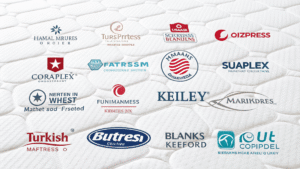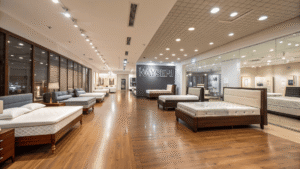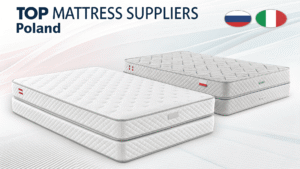Sourcing mattresses internationally can feel like a minefield — too many unknowns, too much risk, and too little time.
To compare Chinese and Turkish mattress suppliers1, analyze cost breakdowns, lead times, compliance, communication ease, and your specific market needs.

When you're sourcing for your retail brand or wholesale business, every decision impacts your margin, timeline, and credibility. Both China and Turkey have their strengths in mattress manufacturing2 — but knowing which one aligns with your needs takes more than just comparing unit prices.
What is the difference between Chinese and Turkish mattress manufacturers?
At first glance, both countries export thousands of mattresses yearly. But their structure, product types, and target markets reveal big differences.
Chinese suppliers focus on high-volume, global production with advanced automation. Turkish factories prioritize European markets, mostly with spring-based designs.

Scale, Focus, and Factory Capabilities
China’s mattress industry is built on scale. We run facilities with 100–300 workers per line, producing foam, spring, latex, and hybrid units under strict quality systems. Brands like Sleemon and DeRUCCI handle both domestic and export markets with ISO-certified production.
Turkey’s mattress sector is smaller — about 400 companies in total. Most are based in Kayseri or Istanbul, and 95% of their output is spring mattresses. They focus heavily on exporting to Germany, France, and nearby MENA markets.
If you're sourcing foam-heavy SKUs or hybrid models with memory foam layers, China offers more R&D flexibility. If you focus on spring-based mattresses for a European audience with faster logistics, Turkey may be a better fit.
| Feature | China | Turkey |
|---|---|---|
| Factory Size | Large-scale, automated | Mid-sized, semi-automated |
| Mattress Types | Hybrid, memory foam, latex, spring | Mostly spring, few foam lines |
| Main Export Focus | Global (US, EU, Asia, Africa) | Europe, Middle East |
| Material Innovation | Strong R&D across materials | Some organic fiber innovation |
| OEM/ODM Flexibility | High | Moderate |
Are Chinese mattresses good quality?
Some importers think “Made in China” means low-end. But the truth depends on the factory you choose and how you manage quality control.
Chinese mattresses range from low-cost bulk items to premium products with full international certifications. It depends on the factory.

What Makes a Good Mattress from China?
We work with international brands who demand strict certifications — OEKO-TEX, CertiPUR-US, ASTM flammability, and ISO9001. These are non-negotiable. And we pass those tests before mass production.
That said, there are suppliers who focus purely on low-cost exports — and those mattresses often lack proper edge support, contain low-density foam, or don't fully expand after shipping.
We advise all buyers to:
- Always inspect foam recovery on compressed samples
- Check wire gauge on spring units
- Verify certification status of each component
- Ask for post-production testing data
The more detail you demand upfront, the lower your complaint rate post-delivery. For buyers who run online stores or supply physical retail chains, these steps protect both your margins and your brand.
Why do buyers choose Turkey over China for mattress sourcing?
European buyers often lean toward Turkey — not because of price, but because of location, logistics, and policy alignment.
Turkey’s proximity, no EU tariffs, and faster shipping make it attractive for European buyers focused on spring mattresses.

Strategic Advantage in EU Trade
Turkey’s biggest strength is speed to Europe. Shipments from Istanbul to Berlin take under a week. From Chinese ports, you’re looking at 4–6 weeks. This difference has a big impact on cash flow, inventory turns, and container planning.
The EU-Turkey Customs Union3 also gives Turkish mattress exporters an edge — their goods clear customs without added duties. Chinese mattresses, in contrast, incur full EU tariffs. For buyers managing warehouse space and local retail schedules, this matters.
US buyers also face high antidumping tariffs on Chinese mattresses — up to 1,731%. Turkish mattresses? Typically between 20.03% and 37.04%. That’s a game changer in FOB landed cost.
But Turkey also has trade-offs. If you're looking for memory foam options, certified bamboo covers, or zipped euro-top hybrids, the selection may be limited. Most Turkish factories prioritize traditional spring production with fewer R&D variations.
How to choose between a Chinese and a Turkish supplier?
The best choice isn’t always the cheapest. It's the supplier who fits your cost, quality, and delivery expectations.
To choose the right supplier, evaluate total landed cost, customization needs, quality proof, and communication responsiveness.

A Practical Checklist for Comparison
Here’s how we advise new clients to decide:
1. Total Landed Cost
Always include product cost, shipping (FOB or CIF), import duties, and any local handling charges. For many EU buyers, Turkey offers cost predictability. For global or US buyers, China remains competitive due to scale.
2. Product Type & Flexibility
If your catalog includes hybrid beds, boxed memory foam, or latex layers — China is your best bet. Turkish manufacturers are more focused on classic spring models.
3. Certifications
Chinese factories like ours can provide CertiPUR-US, OEKO-TEX, ISO9001, and even BSCI if needed. Turkish factories may have EU-compliant certs, but fewer have foam-specific ones like CertiPUR.
4. Sample Speed
From China, you can receive a compressed sample door-to-door in under 10 days. In Turkey, sample coordination is often slower.
5. Communication & Support
We offer 24/7 support over WhatsApp and email. Some Turkish suppliers operate in local time only and may not have fluent English staff across all shifts.
6. Market Fit
Match your supplier to your end market. If you’re serving UK or Australian buyers, customs compliance, label accuracy, and compression quality all play a role.
| Evaluation Factor | China | Turkey |
|---|---|---|
| Landed Cost (EU) | Higher due to tariffs | Lower due to no tariffs |
| Product Customization | Strong (OEM/ODM flexibility) | Limited options |
| Quality Certifications | Available (CertiPUR, OEKO-TEX) | Available but fewer options |
| Sample Speed | 7-day door-to-door | Often slower |
| Communication | 24/7 English support | Limited by time zone |
| Reputation | Check Alibaba + Export history | Use TradeMap + buyer forums |
Conclusion
Choosing between China and Turkey isn’t about which country is better — it’s about which one fits your product line, budget, and lead time expectations.
-
Explore this resource to understand the key differences in sourcing mattresses from China and Turkey, helping you make informed decisions for your business. ↩
-
This link will provide insights into the manufacturing processes in both countries, crucial for selecting the right supplier for your needs. ↩
-
Understanding the EU-Turkey Customs Union can help you navigate tariffs and logistics, making it essential for European buyers. ↩




